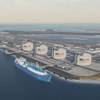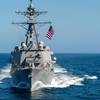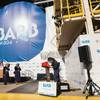Department of Navy leaders at the Naval Future Force Science and Technology (S&T) EXPO in Washington D.C., February 5 called for investment in new ideas and scientific research to keep the U.S. Navy and Marine Corps technologically superior in increasingly uncertain times.
Sean J. Stackley, assistant secretary of the Navy for research, development and acquisition, said tight budgets at home and technological advances by other nations must be met with a powerful response grounded in innovation from the U.S. Navy and Marine Corps S&T community.
"It takes good ideas at the front end to carry them all the way through the design, development and the fielding to provide those superior weapons for tomorrow," said Stackley, one of three members on the Department of the Navy's Research, Development, Technology and Engineering Corporate Board, which just approved a recent update to the Naval S&T Strategy.
Updated every two years, the strategy guides investments in scientific research, technology and talent to develop and deliver a range of technologies and capabilities for Sailors and Marines.
Chief of Naval Research Rear Adm. Mat Winter led a panel discussion at the EXPO featuring all three members of the corporate board: Stackley; Gen. John Paxton Jr., assistant commandant of the Marine Corps; and Adm. Michelle Howard, vice chief of naval operations.
The board members said the Naval S&T Strategy's nine focus areas would guide technological breakthroughs for decades to come and assure access to the maritime battlespace; autonomy and unmanned systems; electromagnetic maneuver warfare; expeditionary and irregular warfare; information dominance-cyber; platform design and survivability; power and energy; power projection and integrated defense; and warfighter performance.
Howard emphasized the need for the Navy to continue exploring alternative sources of power and energy for ships, installations and revolutionary weapons like the Laser Weapon System and Electromagnetic Railgun that don't require gunpowder. Cybersecurity also "is an area ripe for innovation," Howard said.
Paxton cited past examples of technological advances as inspiration moving forward, from the Higgins Boat that made possible amphibious landings during World War II to more recent projects like QuickClot, a life-saving, blood-clotting technology sponsored by ONR.
Technological advancements made during World War II created a U.S. military that was unbeatable on land, at sea and in the air, the panel members agreed.
"Since that time, our defense strategy, our national security strategy had to be based upon technological superiority," Stackley said.
Like past breakthroughs, future technologies will begin with intense discussion and collaboration by decision-makers in government, academia and industry, the board members said.
"It's not an accident that the three of us are up here," Paxton said, noting that all three of the speakers are in constant contact regarding Navy and Marine Corps challenges. The updated Naval S&T Strategy "is a cooperative and collaborative strategy that we truly believe will bring us success on the battlefield and collectively make us a better nation," he said.
The participants stressed the importance of forums like the EXPO, which brings experts together for exchanging ideas, and the updated strategy, which helps turn those ideas into new technologies that can be used by the future force.
"It's very important to understand where we should be going and where we need to be going," Winter said.
navy.mil















